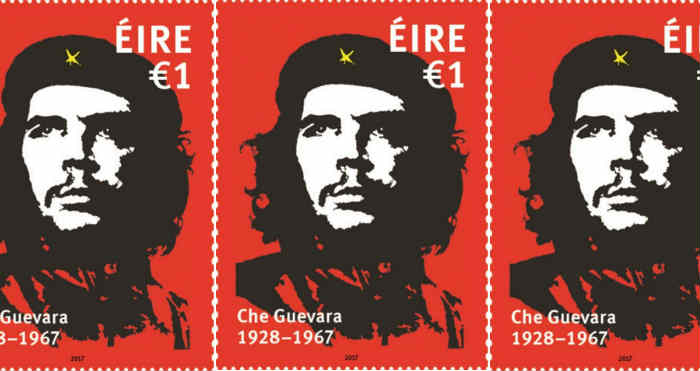The Irish postal service releases a stamp tomorrow commemorating the iconic monster
Ireland honors dead commie Che Guevara

The postal service in the Republic of Ireland has decided to honor psychopathic mass-murdering communist Ernesto “Che” Guevara with a €1.00 (one euro) postage stamp on the 50th anniversary of his death. The decision was approved by Ireland’s cabinet, which didn’t bother to submit the matter to the Oireachtas, the country’s parliament.
“The promotion of Che Guevara as some kind of folk hero is nothing new; college campuses are filled with students unironically wearing Che tee-shirts,”
Frank Camp writes at the Daily Wire. “Unfortunately, much like a cockroach, every time Guevara’s legacy is shown to be one of thuggery and murder, his deity-like status among progressives returns as if it had never been dismantled, and we see things like Ireland’s commemorative stamps.”
There is some sick hero worship of Guevara in Ireland
On a certain level, Ireland honoring Guevara makes sense.
After all, the premier of the then-neutral Republic of Ireland, Eamon de Valera, and the president, Douglas Hyde, did
infamously attend at the embassy of Nazi Germany in Dublin to offer official condolences upon learning of the death of Adolf Hitler.
Earlier this year, the Irish government put a picture of Guevara on display at Miami’s airport as part of an exhibition highlighting the various contributions of people in South America who had ties to Ireland. A backlash among southern Florida’s Cuban-American population ensued and the Irish government took the picture down and apologized, no doubt half-heartedly.
Guevara
did have ancestral ties to Ireland. His eight great-grandparents were from Galway. His father, Ernesto Guevara Lynch, said “in my son’s veins flowed the blood of Irish rebels.”
There is some sick hero worship of Guevara in Ireland (and, unfortunately, a lot more of it in the United States). There is the
annual Che do Bheatha Festival in Kilkee, County Clare, “which celebrates Che Guevara spending a night at the Royal Marine Hotel in Kilkee on September 12, 1961.” One locality on the Emerald Isle is apparently planning to erect a statue to honor him.
Now would be a good time to recap what Guevara actually did.
Guevara was both a monster and an incompetent bumbler, according to
Discover the Networks.
He complained about how hard it was to community-organize Bolivia. “We cannot develop any peasant support,” he wrote. “But it looks like by employing planned terror we may at least neutralize most of them. Their support will come later.” He managed to scrap together maybe 40 or 45 guerrillas at most for what he pompously called his “National Liberation Army.”
Before that, Guevara spent years wrecking Cuba. He was named that country’s minister of economics in 1960. In a few months, the Cuban peso was almost worthless. He was made Cuba’s minister of industries the next year. Inside of a year, the formerly well-off country was rationing food, shutting down factories, and driving away “hundreds of thousands of its most productive citizens, who were happy to flee with only the clothes on their backs.” (Some years back, Nick Gillespie of Reason TV
did a very good video about Guevara.)
As Jay Nordlinger
has written,
He was an Argentinian revolutionary who served as Castro’s primary thug. He was especially infamous for presiding over summary executions at La Cabana, the fortress that was his abattoir. He liked to administer the coup de grace, the bullet to the back of the neck. And he loved to parade people past El Paredon, the reddened wall against which so many innocents were killed.
Furthermore, he established the labor-camp system in which countless citizens–dissidents, democrats, artists, homosexuals–would suffer and die. This is the Cuban gulag. A Cuban-American writer, Humberto Fontova, described Guevara as “a combination of Beria and Himmler.” Anthony Daniels once quipped, “The difference between [Guevara] and Pol Pot was that [the former] never studied in Paris.”
Guevara didn’t give a farthing’s cuss about due process. “Evidence is an archaic bourgeois detail,” he said, sounding like a modern-day American university sexual harassment tribunal. “We execute from revolutionary conviction.”
Guevara got what he so richly deserved on October 9, 1967, when a Bolivian firing squad executed him for trying to overthrow that country’s government. In a rare instance of U.S. taxpayer dollars being spent wisely, the CIA helped bring him to justice. Five years before his death, after the Cuban Missile Crisis, he wrote that if he had his druthers, he would have nuked the U.S. “If the missiles had remained [in Cuba], we would have used them against the very heart of the U.S., including New York City.” He added, “[t]he victory of socialism is well worth millions of atomic victims.”
Perhaps Antifa subversives will begin marketing the commemorative stamps to raise money.
(Hat tip to
Paddy J. Manning)
Matthew Vadum -- BombThrowers -- Bio and
Archives |
Comments
Matthew Vadum, matthewvadum.blogspot.com, is an investigative reporter.
His new book Subversion Inc. can be bought at Amazon.com (US), Amazon.ca (Canada)
Visit the Subversion Inc. Facebook page. Follow me on Twitter.

